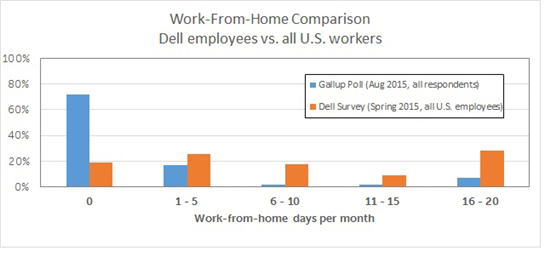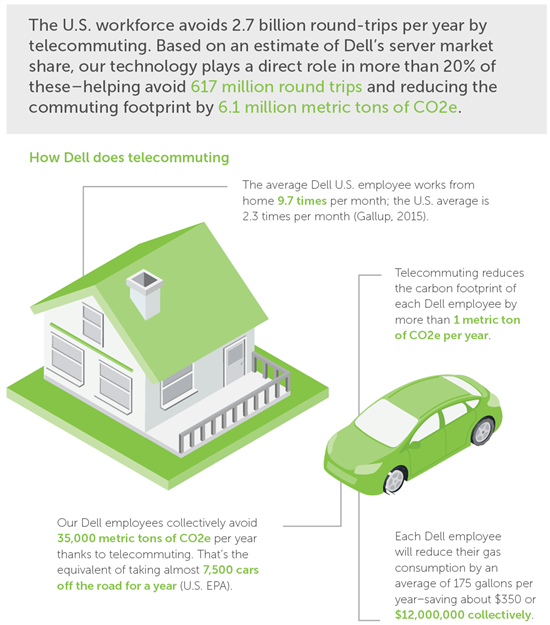“Roads? Where we’re going we don’t need roads.”
Dr. Emmett Brown’s words are certainly inspiring. Perhaps immortal in some sense. I’d like to say they applied to our Legacy of Good goals. But they don’t. At least not yet.
When we announced our Legacy of Good plan in October of 2013, we knew we had set an ambitious target. We also knew that many of the roads that would help us reach it had not yet been built. Not only that, we had no idea as to what a flux capacitor for corporate social responsibility looked like. We were going to have to create our own path.
So, we started building, beginning a series of pilot studies to learn how to measure the sustainability benefits and impacts of IT solutions. One of these has been our investigation of “The Sustainability Benefits of the Connected Workplace.” Dell’s Connected Workplace program is our formal version of what’s commonly called telecommuting, but has also been referred to as telework, remote work, flex work or simply work-from-home.
Why remote work?
We picked the study of work-from-home deliberately.
First, we knew that we were not the first to study this. That meant we could learn how to measure IT solutions without having to create everything from scratch. It also meant there would be other studies with whom we could compare our results.
Second, we knew we had a dog in this hunt. Our hardware products are frequently the backbone that supports telecommute initiatives. Our SonicWALL software and Aventail appliances also provide support through VPN services that enable secure communication between an employee at home and the company data center.
Third, we’re strong believers in work-from-home ourselves, having both our formal program (Connected Workplace), informal initiatives, as well as a 2020 goal for flex work. A study of our program and our results would be meaningful not only as a measure of our success at implementing ‘flex work,’ but also as a marker of what a company comprised of information workers can achieve.
Surprise, surprise—a lot of us work from home
Not surprisingly, we found some of our study’s results to be similar to others’. That being said, there were big differences between the experiences of the Dell U.S. worker and the average U.S. worker. Our program is significantly further along than most, though this is, in part, due to the nature of our business and our work.
We found that, collectively, our U.S. employees avoid 135 million miles of driving per year by working from home. We found that the average Dell U.S. employee sees a reduction in their carbon footprint of a little over one metric ton of CO2-equivalent per year. This reduction is mostly based on reduced miles travelled by our employees, but also considers the ‘rebound’ effect of employees using more electricity at home during the day, at a time when they’d otherwise be in a Dell office. We also found, to our pleasant surprise, that the average Dell U.S. employee works from home a little over 9.5 days per month. Now, to be fair, this includes some Dell employees who are strictly customer-facing or partner-facing and do not live near a Dell facility. Still as an average across all Dell U.S. employees, it’s a pretty impressive number.
Okay? But what about our top-level 10×20 goal?
Our 10×20 goal is the greatest aspiration for our Legacy of Good plan: to show that the positive social and environmental benefits from the use of our technology are ten times its impact.
So, while we’re definitely interested in what Dell has achieved, we want to estimate what our customers have achieved as well.
The final methodology and numbers from our Connected Workplace study will need more scrubbing, more review. The early analysis, however, suggests that Dell technology is currently helping our customers and their employers avoid over 600 million round-trip commutes per year, with a corresponding reduction in emissions of over six million metric tonnes of CO2e per year. That’s material to our 10×20 goal, given that our FY16 emissions from sold product were twelve million metric tonnes of CO2e. Our work-from-home study is the first study we’ve completed that compares materially to our overall footprint. Work-from-home moves the needle on our 10×20 goal.
By the way, let’s be clear: this is not just an accomplishment by Dell technology, but also all the participants in the value chain for these solutions, including our customers and their employees. These are shared benefits. If any of us—hardware vendors, network providers, software vendors, operators, users—don’t do our part, these benefits aren’t possible.
Now, can you take me back to the future?
If we’re accomplishing this much today, what does that mean for tomorrow? This was perhaps one of our biggest surprises. Telecommuting, though it has a long way to go, may be further along in adoption than convention wisdom would dictate.
A poll conducted by Gallup in August of 2015* found that 37 percent of respondents had telecommuted and that 28 percent of U.S. workers telecommute one or more days per month. This is an increase from 23 percent in 2008. Considering all workers, including those who do not telecommute, Gallup found that the average employee worked from home 2.3 days per month.
So, the data says much of the U.S. workforce is already telecommuting, though possibly in a dipping-your-toes-in-the-water sense. This is okay; telecommuting is not one-size-fits-all. While estimates vary and data is scarce, one study suggests that 40 percent of all jobs support telecommuting. Even for those that do, 5 days a week may not be necessary. Moderation may be the best policy—other work suggests that the optimum frequency for greatest productivity for many roles may be between 2 and 3 days per week. Still, 2 to 3 days per week represents a lot of opportunity when you compare it to 2 to 3 days per month.
Net: there are still some of us that could try telecommuting, and, those who occasionally work from home may have the opportunity to explore a bit further. We’ve come far, but there’s opportunity for more.
Well, what did we learn?
We learned a lot from our Connected Workplace study.
Working from home allows our employees to do their jobs, while reducing their commute times, gasoline consumption and their personal carbon footprint. At the same time, remote work has a positive effect on social and work-life-related benefits.
Sara Sutton Fell, CEO and Founder of FlexJobs, mentioned in our recent #CSRChat on Twitter that flex work supports corporate social responsibility in many ways—including that employees may have less commute time and more time to volunteer .
We have a much better idea as to how to conduct these studies and analyze and scale results. We also found that our aggregate benefits are in line with results suggested by other studies and that there is a lot more to achieve.
Last, we found that, as valuable as these programs are to our employees, the benefits and opportunities extend across the U.S. workforce. And that today these shared benefits may amount to a reduction of carbon emissions equal to half of our sold product impact.
Not bad for one of our early studies. Now, where did I park the DeLorean?
As part of our 2020 Legacy of Good Plan, Dell has an ambitious goal to enroll 50 percent of its team members in Dell flexible work programs. We are well on our way, with 1 in 4 eligible Dell team members enrolled.
Explore the entire Legacy of Good Plan at Dell.com/legacyofgoodupdate
*Gallup PDF with specific poll data can be found at http://www.gallup.com/file/poll/184658/Telecommuting_150819.pdf (Gallup, 2015)



